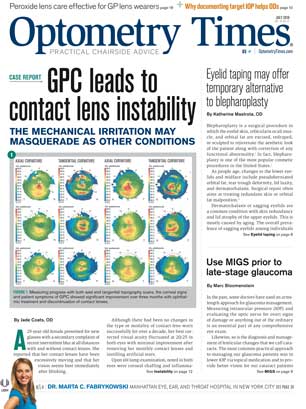Why documenting target IOP helps ODs
Treatments continue to evolve, and glaucoma treatments are no different. When treating glaucoma patients, it is important to stay up to date on new technologies and continue to monitor IOP.


A good friend and colleague recently asked me whether I still documented target intraocular pressures (IOP) when treating glaucoma. My short answer was yes. Although there are numerous and various medical and surgical routes to achieve lower IOP, the overriding theme to treating glaucoma is a “point A to point B” approach.
Simply put: lowering IOP is still essentially the only thing ODs can do for glaucoma patients-and ODs still subscribe to landmark studies when doing so.
Lowering IOP still beneficial
One such study that I have quoted numerous times over the years during lectures has been the Collaborative Normal Tension Glaucoma Study (CNGTS).1 In this landmark longitudinal study, the investigators found that lowering IOP in patients was still beneficial even in the face of so-called “normal” baseline pressures.
The big number that came out of this study was 30 percent. One eye of eligible patients was randomized to a 30 percent IOP reduction or a control (no pressure reduction). Treatment was medical (with topical ocular hypotensive agents) or surgical (filtration surgery).
The endpoint results were measured as visual field preservation over a period of years. These results were adjusted to account for the effects of post-surgical cataracts in the surgical arm of the study. When this study took place, minimally invasive glaucoma surgeries (MIGS) did not exist.
However, when adjusted, these results pointed to the fact that the treated eyes had a 50 percent less chance of deteriorating visual fields over a five-year period than did the control eyes.
Importantly and correctly, researchers made note of the fact that not all of the control eyes progressed. This prompted researchers to advise the clinician to take this into account when deciding on management of normal tension glaucoma patients on an individual basis.
Previously from Dr. Casella: Involve patients in monitoring IOP
Not all glaucoma patients are going to progress. Those patients who do will progress at different rates. In light of this notion, it may be beneficial in some cases to perform multiple diagnostic studies before the decision to treat or monitor the patient is made.
Target IOP a must
Another landmark study which has a direct impact on choosing target IOP for a patient is the Ocular Hypertension Treatment Study (OHTS).2 The big number that came out of this research was 20 percent.
In this longitudinal study, 1636 patients with no evidence of glaucoma were included. The goal of the investigators was to reduce IOP by at least 20 percent and to reach an IOP of 24 mm Hg or lower. Over the years of the study, investigators were able to show that achieving such a goal significantly cut an ocular hypertensive patient’s chance of converting to glaucoma.
Establishing and documenting target IOP accomplishes several tasks for the clinician:
• Target IOP give the clinician a goal to achieve with therapy and-along with visual field studies, optical coherence tomography studies, and other ancillary tests-a metric by which the effectiveness of therapy can be measured.
• Establishing these target pressures and basing them on landmark glaucoma studies shows that clinicians are keeping up with contemporary glaucoma standards of care-and these standards evolve over time as newer studies are published, which compel clinical approaches to be updated.
Keep up to date
I am grateful for my friend’s question regarding target IOPs. It prompted me to go back and re-read the results of CNGTS and OHTS. Besides taking continuing education courses, I also periodically go to www.pubmed.gov to search the world’s literature with the keyword “glaucoma” just to see what is being studied these days.
Sometimes I come across interesting concepts that are to be explored in the future, and sometimes I come across large longitudinal studies I have not heard of yet.
As a small-business owner, it is important for me to not get too bogged down in the day-to-day life of my practice and to examine how I am practicing, ensuring that I am keeping with contemporary standards. My colleague’s question prompted me to do just that.
References:
1. Collaborative Normal-Tension Glaucoma Study Group. The effectiveness of intraocular pressure reduction in the treatment of normal-tension glaucoma. Collaborative Normal-Tension Glaucoma Study Group. Am J Ophthalmol. 1998 Oct;126(4):498-505.
2. Kass MA, Heuer DK, Higginbotham EJ, Johnson CA, Keltner JL, Miller JP, Parrish RK 2nd, Wilson MR, Gordon MO. The Ocular Hypertension Treatment Study: a randomized trial determines that topical ocular hypotensive medication delays or prevents the onset of primary open-angle glaucoma. Arch Ophthalmol. 2002 Jun;120(6):701-13; discussion 829-30.
Newsletter
Want more insights like this? Subscribe to Optometry Times and get clinical pearls and practice tips delivered straight to your inbox.
